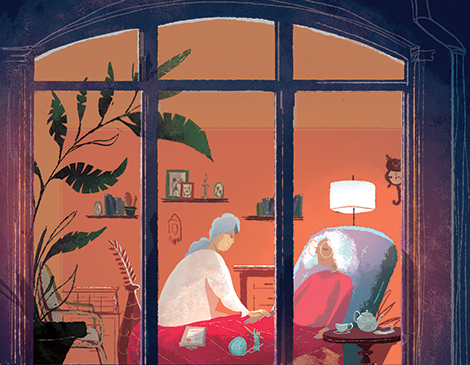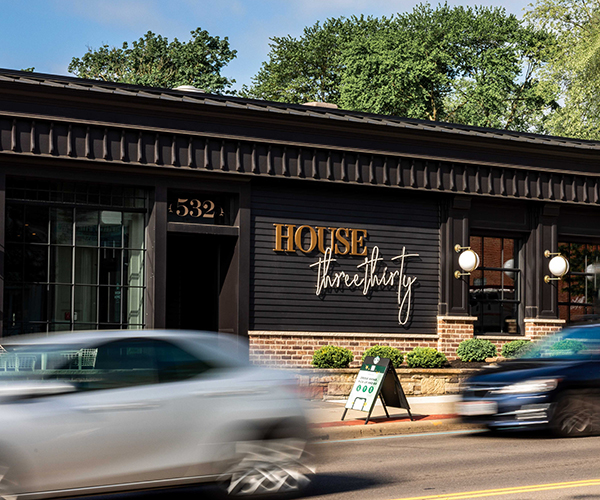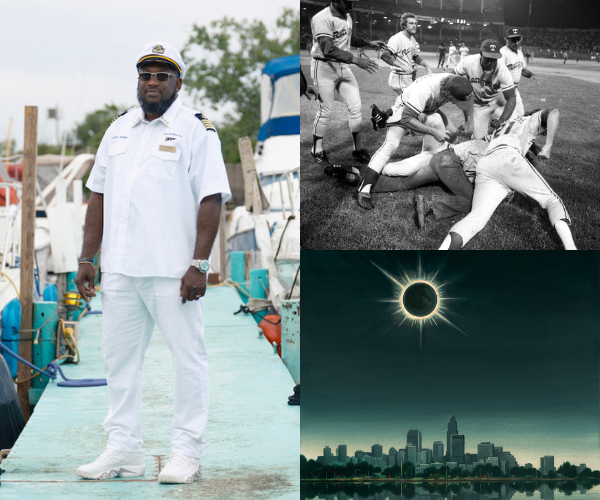Sheila Burke allows me a peek into her work bag. She pulls out a brass singing bowl, a few crafts, including coloring books and writing prompts, a small bag of crystals — “if you’re into that sort of thing” — and a few informational books on death.
As a trained end-of-life doula, Burke uses these tools to educate and soothe the patients she works with — many of whom have just months, weeks, days left to live. And while death can be an uncomfortable topic for many, Burke is right at home guiding folks through it.
Caregivers like Burke, also called death doulas, aren’t much different than their obstetric counterparts. Organizations like the non-profit International End of Life Doula Association — of which Burke is a member — or the end-of-life support program at the University of Vermont, assist people through a confusing, healthcare-ridden time by informing and guiding them through their medical and emotional options.
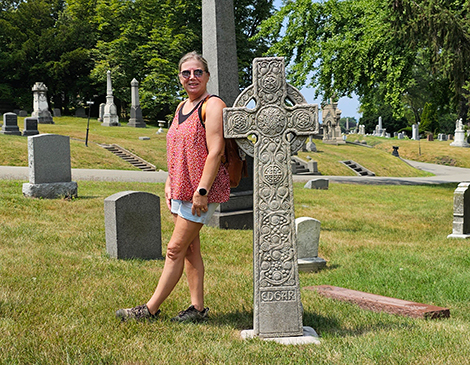
(Courtesy Sheila Burke)
Despite the practice’s conception around the ’80s and ’90s, death doulas have only grown in popularity in the past five to 10 years. INELDA itself didn’t form until 2015.
“A lot of people don’t really understand what we do,” Burke says. “I’m 58 … anyone really who’s my age and older has a tough time understanding what the whole doula thing is. They think it’s, like, hippy-dippy. You know, Woodstock kind of stuff. We’ve made it in this country so taboo to talk about death.”
Burke’s openness to death, however, came from a need to confront it. In 2019, her seemingly healthy husband of 32 years, Shane Burke, was diagnosed with stage-four, small-cell lung cancer at 56. The diagnosis is often aggressive and somewhat rare — less than 15% of lung cancer diagnoses — with an aptitude for spreading through the body.
Just before his diagnosis, Shane seemed relatively fit. An avid lover of rock band AC/DC and golf, he and Sheila operated a window cleaning business in Parma. It was fall, a busy time for the couple, when a persistent cough and bit of blood coaxed Shane to a doctor.
One X-ray led to another. And then a CAT scan. The process quickly snowballed as information flew at the couple. A cough, the blood, a spot on the lungs that was “probably nothing, but I see some cloudiness,” their Cleveland Clinic doctor told them.
“The tech said, ‘We’ll have the doctor post the results on MyChart in three to five days,’” Sheila recalls. “What was maybe like an hour and a half, two hours later, and he got a call that said, ‘It looks like cancer. We’re going to refer you to an oncologist.’ And we were like, ‘This is crazy!’”
When the family asked for a prognosis, the doctor responded with a glib “couple of months.”
“I just lost it,” Sheila says. “Everyone’s handing me tissues. My daughter’s rubbing my back, and my husband’s rubbing my head. He’s not even crying.”
Diagnosed in November 2019, Shane quickly began treatment: chemotherapy that would take its toll on his quality of life, if buying him a few extra months.
The next 10 months were relentless. The Burkes’ children traveled back home for regular visits — a daughter working in Manhattan, a son in grad school at Columbia University and another daughter in Columbus with a newborn baby.
When Shane declined to the point of hospice, Sheila kept spirits up in the form of a legacy project. She and everyone close to her husband wrote letters to him expressing their love.
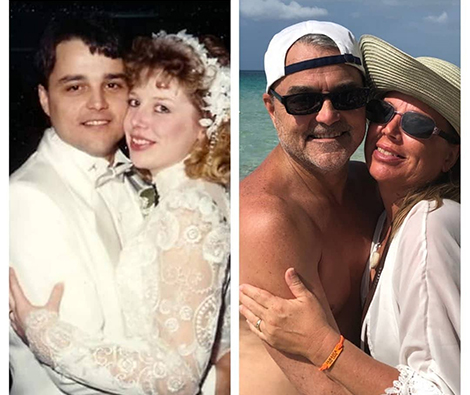
(Courtesy Sheila Burke)
“He bawled his eyes out,” Sheila says. “And he read each letter very carefully. His poor little hands, he’s just so frail, and he’s holding these things. And he was like … I can’t believe I made a difference.”
By September 2020, Shane succumbed to the cancer that had spread from his lungs to his liver, his bones, and three “tiny spots” on his brain.
Now, reflecting on that tumultuous time, Sheila wishes she had just been more informed. With everything moving at a breakneck pace, even doctors seemed short on time and answers.
She remembers that moment in the waiting room when they got the diagnosis. She wanted to know what her options were, if certain holistic remedies she’d seen might help. The doctor “laughed at me, literally laughed at me really, and said, ‘That’s not going to work.’”
Moments like this are all too common in healthcare, says medical sociologist Dr. Clare Stacey, a researcher and associate professor at Kent State University. It exemplifies the need for someone qualified to help guide patients through their wants and needs.
“It’s not like it’s an evil medical system,” Dr. Stacey says. “It’s just a system, and a system does things with an eye for efficiency and for ease and … so you don’t get your ass sued. That all kind of points in the direction of not being very clear about death. And also, doctors aren’t always trained to talk about this. So, a death doula can be that bridge.”
Only a few weeks after Shane’s passing, Sheila stumbled upon that bridge in the form of an article. In it, she read about death doulas and a concept she’d never heard of — a good death.
As she researched the “good death,” Sheila thought about all she’d done for Shane. The legacy project she’d completed for him turned out to be a common practice among the death doulas, along with facilitating the emotional and physical needs of a patient.
That research led her to INELDA, which offers structure to the largely unregulated world of death doulas through end-of-life training and certification.
Another local INELDA member, Anne O’Neill, became a doula after years working in geriatrics at University Hospitals and as a Hospice of the Western Reserve clinical manager. With her insight, she stresses that doulas provide for patients in ways healthcare often can’t.
“A doula really isn’t about the family; the focus is on the patient,” she says. “So much of end-of-life goes on around a patient. It doesn’t involve them.”
But doulas like O’Neill talk patients through their options — difficult decisions sometimes pitting life-extending treatment versus comfort.
Since her training began in 2020, Sheila has written four short books on death that she provides to new patients to help with their understanding. She’s also provided her service free of charge to more than a dozen families.
When a patient contacts Sheila through her website, she starts with an earnest conversation. She wants to know how they view their life, how they view their death, where they want to be at the end of their time and what that space looks like.
READ MORE: Retirement Living: Coping With a Love Lost
She might spur them to start their will, talk through do-not-resuscitate options and help them navigate the various moving parts of palliative care like nursing homes and hospice.
And, as O’Neill has seen, healthcare organizations are beginning to understand the need for end-of-life doula care.
“I have been approached by so many hospitals, hospices [asking], ‘Annie, how can we do this? How can we as an organization provide what an end-of-life doula provides?’ And my response is always the same. You can’t.”
The Cleveland Clinic and University Hospitals have no on-staff end-of-life doulas. While the Clinic maintains ties with O’Neill and Hospice of the Western Reserve formed an official doula program in 2021, both rely on willing volunteers.
A doula needs to be there for a patient when the doctors and hospice can’t be, O’Neill adds. And most hospitals simply don’t offer the emotional training that doulas receive through organizations like INELDA.
“I’m in the process now of getting certified, which was a grueling process,” Sheila says. “You need so many hours with so many patients. It literally took me over a year to meet the requirements.”
But that hard work, however taxing, pays off for Sheila when she thinks of Shane. So many people die without having their needs met, but an end-of-life doula makes it their mission to ease that burden.
As Sheila packs her bag for work after our hour-long conversation about Shane, she seems confident and peaceful. She never cried for a moment. With an earnest smile and a sense of respect, she meets death, head-on.
READ MORE: The Grind: Inside Starbucks Workers’ Union Push in Northeast Ohio
Start your day the best way by signing up for our free daily newsletter. Arriving in your inbox every morning to keep you in the loop on the best guides, home and style tips, and news briefs for all things Cleveland. Click here to subscribe.

